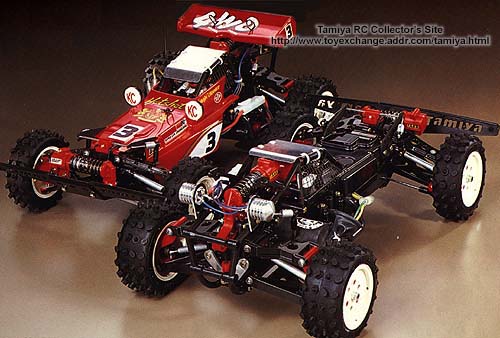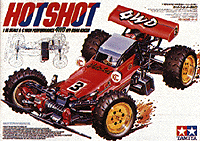Analysis of individual cars
The Hotshot (58047)

The HotShot was kit number 47 from Tamiya. A 1/10 4WD off-road racer, it was the first true 4WD off-road racer from Tamiya.
Specifications
- 1/10 scale on-road car
- 4 wheel drive, center shaft with dogbones at all four wheels
- Plastic tub-chassis
- Fully independent double wishbone suspension
- Coil spring over oil filled monoshock in front and rear
- RS-540 Mabuchi motor
- Off road pin spike/block rubber tires
- Lexan body and rear spoiler
Description
This car started it all for Tamiya in 4WD off-road racing. Prior to the launch of this car, Tamiya didn't really have anything meant for high-speed off-road racing. All other kits before this were scale models as opposed to racing machines. The Hot Shot changed all of this. An all plastic design, it was far simpler than previous cars and significantly lighter too.
The suspension was fully independent and damped by two aluminum monoshocks working off a cantilever system that was pretty effective. Anti-roll bars front and rear controlled single wheel movements. Radio gear and speed controller were sealed inside a plastic tub chassis keeping dirt and moisture out.
Being one of the first plastic cars from Tamiya, much of the car's design showed inexperience. But it would be just like Tamiya to err on the side of overly robust. The dog bones or half shafts were a complex design of harden steel tips with light aluminum center shaft. Overly complex with little weight savings. The speed controller used aluminum heatsinks that were very scale (and tough) looking but again, expensive to produce. The center drive shaft was made of harden steel with brass hex ends. The brass was intended to wear faster than the steel drive cups that they connected to. The rationale being that the customer would only have to replace the drive shaft over time. Like I said; over engineered.
Having said all this though, the HotShot was still light years ahead in design. Racers took one look at this car and saw potential. It was lightweight for its time and the suspension allowed for more travel and tuning than any other car available from Tamiya. The central drive shaft was easy to assemble and relatively maintenance free.
In fact, the design was so popular and reliable that Tamiya would later use it for many other four wheel drive cars, the Super Shot, HotShot II, Boomerang, Super Sabre and Big Wig. Each time they used it, they improved upon the original.
The car sold in record numbers and racers soon put the car through its paces on off-road tracks. Companies such as CRP and Hot Trick started to issue aftermarket improvement parts for the car. For a lot of people, the HotShot was their introduction to the world off-road R/C racing.
Historical Significance
 This was the first four wheel drive race car for Tamiya. And for a lot of people their first introduction to Tamiya and to the world of R/C racing. All of these fond memories can only help increase the desirability of the kits now that they have been discontinued for close to 15 years.
This was the first four wheel drive race car for Tamiya. And for a lot of people their first introduction to Tamiya and to the world of R/C racing. All of these fond memories can only help increase the desirability of the kits now that they have been discontinued for close to 15 years.
Add to this the generally higher levels of collector interest in four wheel drive cars and you have a kit that will command some serious prices on the market today. New in box examples can expect to fetch about $450 dollars and up. Mint display models can go for over $200.
Additional Notes
Although the car has been discontinued for a long time, the drive train parts are mostly interchangeable with their most popular 4WD models of the time and that means that these parts are all pretty readily available. The only exception being the front gear box case. Because they were prone to crack on impact, these are usually the first parts to run out at the local hobby store. Actually the entire front suspension was prone to rapid wear. Slack in the front arms just gets worse over time and the steering knuckles snap with annoying regularity.
Purists should note the correctness of the parts before purchasing. Because many parts are so interchangeable, owners sometimes substituted parts from the Supershot or HotShot II in place of the originals for reasons of availability or reliability.
Those that choose to run their HotShot should always replace plastic bearings with ball bearings. Tolerances are so important to the long health of the gears in this car. The slop introduced by worn plastic bearings can wreak havoc on your gearbox internals.
Rating
- Collectibility – 8 out of 10
- Fun to drive – 7 out of 10
- Parts availability – 6 out of 10
